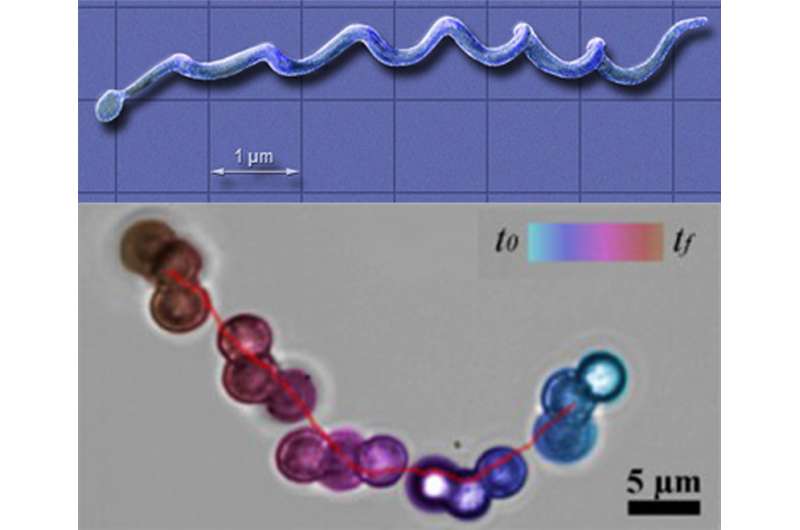Microscale 'transformer' robots are joining forces to break through blocked arteries

Swarms of microscopic, magnetic, robotic beads could be scrubbing in next to the world's top vascular surgeons—all taking aim at blocked arteries. These microrobots, which look and move like corkscrew-shaped bacteria, are being developed by mechanical engineers at Drexel University as a part of a surgical toolkit being assembled by the Daegu Gyeongbuk Institute of Science and Technology (DGIST) in South Korea.
MinJun Kim, PhD, a professor in the College of Engineering and director of the Biological Actuation, Sensing & Transport Laboratory (BASTLab) at Drexel, is adding his team's extensive work in bio-inspired microrobotics to an $18-million international research initiative from the Korea Evaluation Institute of Industrial Technologies (KEIT) set on creating a minimally invasive, microrobot-assisted procedure for dealing with blocked arteries within five years.
DGIST, a government-funded research entity in Daegu, South Korea, is the leader of the 11-institution partnership, which includes some of the top engineers and roboticists in the world. Drexel's team, the lone representatives from the United States, is already well on its way to tailoring robotic "microswimmer" technology for clearing arteries.
"Microrobotics is still a rather nascent field of study, and very much in its infancy when it comes to medical applications," Kim said. "A project like this, because it is supported by leading institutions and has such a challenging goal, is an opportunity to push both medicine and microrobotics into a new and exciting place."
Kim's microswimmers are chains of three or more iron oxide beads, rigidly linked together via chemical bonds and magnetic force. These chains are small enough—on the order of nanometers—that they can navigate in the bloodstream like a tiny boat. The beads are put in motion by an external magnetic field that causes each of them to rotate. Because they are linked together, their individual rotations cause the chain to twist like a corkscrew and this movement propels the microswimmer.
By controlling the magnetic field, Kim can direct the speed and direction of the microswimmers. The magnetism involve also allows the researchers to join separate strands of microswimmers together to make longer strings, which can then be propelled with greater force.
This research, which was recently reported in the Journal of Nanoparticle Research, is one of the reasons Kim's lab was chosen for the ambitious project.
"Our magnetically actuated microswimmer technology is the perfect fit for this project," Kim said. "The microswimmers are composed of inorganic biodegradable beads so they will not trigger an immune response in the body. And we can adjust their size and surface properties to accurately deal with any type of arterial occlusion."
Kim's inspiration for using the robotic swimmers as tiny drills actually came from a malicious bacterium that wreaks havoc inside the body by doing just that—burrowing through healthy tissue. Borrelia burgdorferi, the bacteria that causes Lyme's Disease, is classified by its spiral shape, which enables both its movement and the resultant cellular destruction.
DGIST researchers are planning to harness this behavior in the microswimmmers to lead the way for a vascular probe by loosening the arterial plaque that is causing the blockage.

The probe, which looks like a tiny drill, is being designed by Bradley Nelson from ETH Zurich, a pioneer in the field of microrobotic surgery. The team's plan is to use a catheter to deliver the microswimmers and the drill directly to the blocked artery. From there, the swimmers would push their way into the blockage, then the drill would clear it completely.
Once flow is restored in the artery, the microswimmer chains could disperse and be used to deliver anti-coagulant medication directly to the effected area to prevent future blockage.
This procedure could supplant the two most common methods for treating blocked arteries: stenting and angioplasty. Stenting is a way of creating a bypass for blood to flow around the block by inserting a series of tubes into the artery, while angioplasty pushes out the blockage by expanding the artery with help from an inflatable probe.
"Current treatments for chronic total occlusion are only about 60 percent successful," Kim said. "We believe that the method we are developing could be as high as 80-90 percent successful and possibly shorten recovery time."
More information: Self-assembly of robotic micro- and nanoswimmers using magnetic nanoparticles, DOI: 10.1007/s11051-014-2737-z
Journal information: Journal of Nanoparticle Research
Provided by Drexel University

















